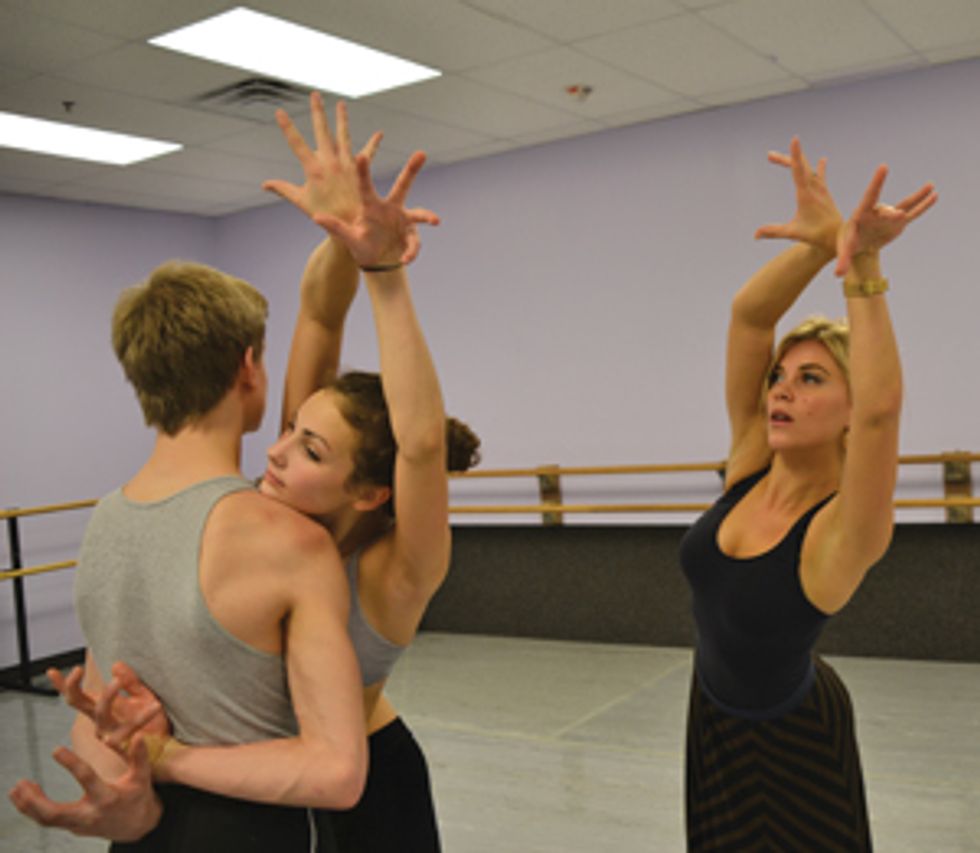Guest Who?

Lauren Adams guest-choreographing at Spotlight Dance Works in Chesterfield, MI (Liz Schmidt)
These days, it’s common for studio owners to hire guest choreographers—often big industry names like Travis Wall and Joey Dowling—to set pieces on their competition dancers. As a dancer, working with a guest choreographer is both exciting (cool new moves from a dance celebrity!) and terrifying (what if she doesn’t see my potential?). But fear not: Lauren Adams, a faculty member at 24 Seven convention and frequent guest choreographer at studios across the country, has the answers to your “I have no idea what to expect from this new person” questions.
I’ve never worked with a guest choreographer before. How should I prepare?
Be open and inviting. It’s intimidating for us to walk into a space filled with dancers, all expecting us to create this great energy.
Researching the choreographer is a great idea—check out his or her website or work on YouTube. Having a sense of the choreographer’s aesthetic will enhance your experience and help you approach the work with confidence.
My teacher always puts me in the front row for our routines. How will the guest choreographer know I’m one of my studio’s top dancers?
Many choreographers hold at least one class with the dancers before they begin choreographing for them. This class works as an audition and an introduction to how we’ll all work together, creatively and energetically. It gives the dancers an opportunity to warm up to us, and it helps us figure out what stylistic direction to pursue.
I also like to observe the dancers while they warm up, when they don’t know I’m watching—that’s the easiest and fastest way for me to assess who they are through my own lens. Then, during class, I’ll choose my cast before we begin the first rehearsal.
How can I stand out?
I value an enthusiastic worker—a dancer who will not only show up on time, but early, ready and warmed up. If I see you working hard to learn the choreography from a section you aren’t in, I may end up pulling you into that section. I want you to get the most out of every rehearsal, so take advantage of the process, learn everything you can and embrace the work.
I also want the dancers I’m working with to look like themselves. I don’t like walking into a studio where the dancers are all wearing slick buns and the same outfit. I only get to work with you for a short time, so I need contrast to tell you apart—and I’m likely to remember the “girl with the long ponytail” or “the one in the red leotard.”
How long will you work with us?
You can expect six to eight hours of work for a group piece and approximately three hours for a solo.
Who picks the music you’ll choreograph to?
I like to pick my own music. I don’t usually connect with music that has been pre-selected for me.

Dancers from Canada’s Elite Danceworx perform one of Adams’ pieces at competition. (Break the Floor Productions)
So you spend a few hours giving us choreography, and then you have to leave. What happens throughout the year?
It’s important to commit to the choreography and develop the character, dynamic and texture of it over the course of the year. If something truly isn’t working, it’s OK for your teacher to make minor changes. Remember, the beauty of the piece lies in how it unfolds over time. Enjoy the process of investigating the work.
Do you ever reuse your work? I’m afraid we’re going to go to Nationals and someone will have our same routine,
Bring It On style.
I don’t. Each studio is unique and I design accordingly. But some choreographers might reuse work, so be sure to have your teacher ask that your piece be exclusively yours.
Can guest choreographers say
no to certain studios if they
don’t want to choreograph for
them?
Yes. I only go to studios where the work ethic is strong. I get a weekend to create work that will be presented for a whole season, so I want to be sure I’m working with dancers who are enthusiastic, self-motivated and willing to work as hard as I am. I’m not afraid to say I won’t be a good fit for a dancer if I can’t get a clear vision of how I would design movement for him or her. In that instance, I’ll recommend a friend or colleague who might be a better match.
Do you ever get to see your pieces performed at competition?
Yes, and I love when that happens. It’s a big payoff. It’s sad to put your heart into your work and only get to see the beginning stages of its development.
Have you ever been disappointed in a piece you set on a studio?
Of course. There have been times when I felt the dancers didn’t stretch to their potential through the work, and that makes me sad. I always do the best I can—and sometimes my best for one studio doesn’t hit me as hard as my best for another. I can learn something from every experience, including rejection and disappointment.
If you like us, will you come back?
I absolutely return to studios year after year—that’s my favorite part! The dancers and the choreographer get to grow together. You come on my journey, and I get to go on yours. I care about my students, and I love getting to call them my students. I want to be better each year for them and create different work from what they’ve come to expect. I want to know dancers for the duration of their careers.




